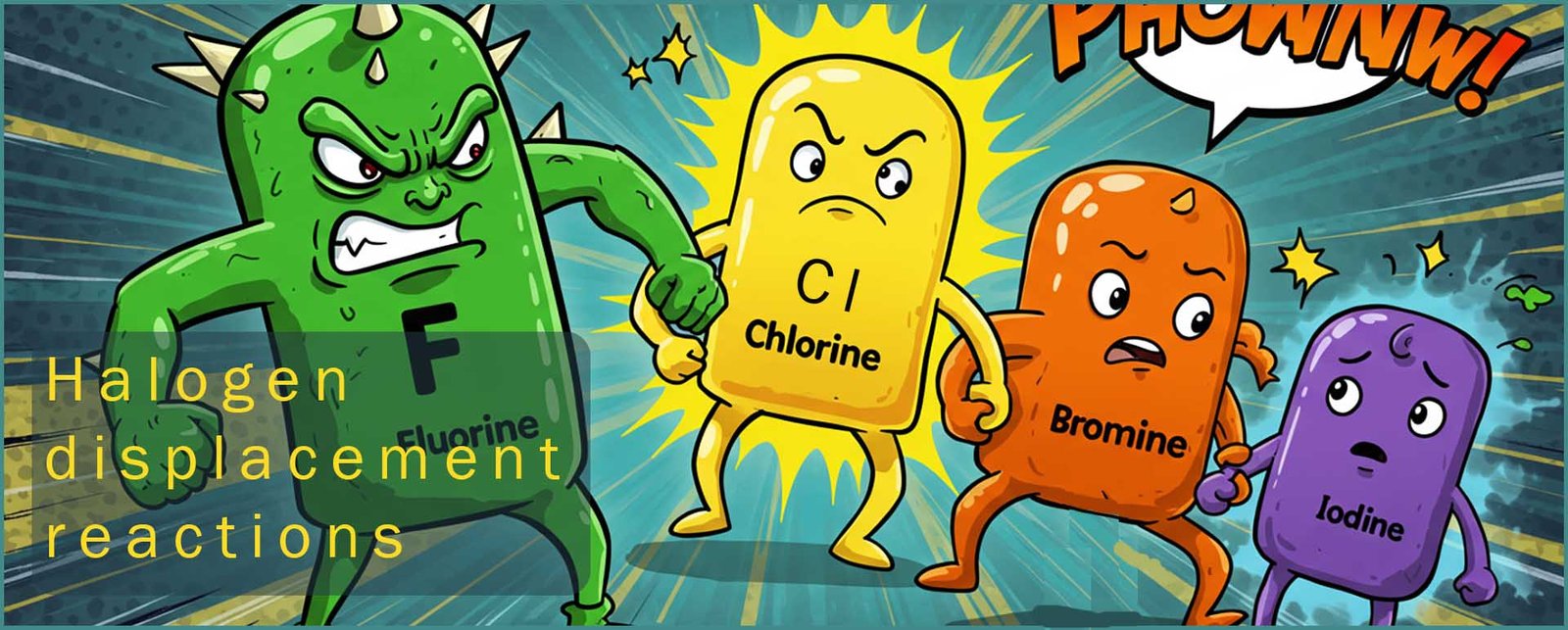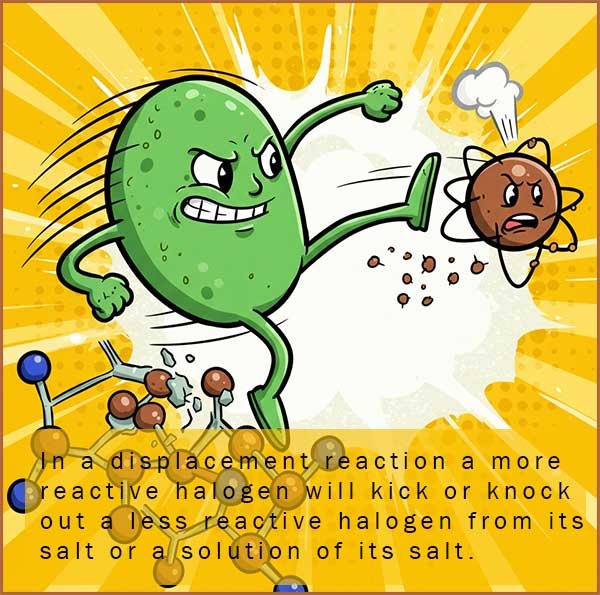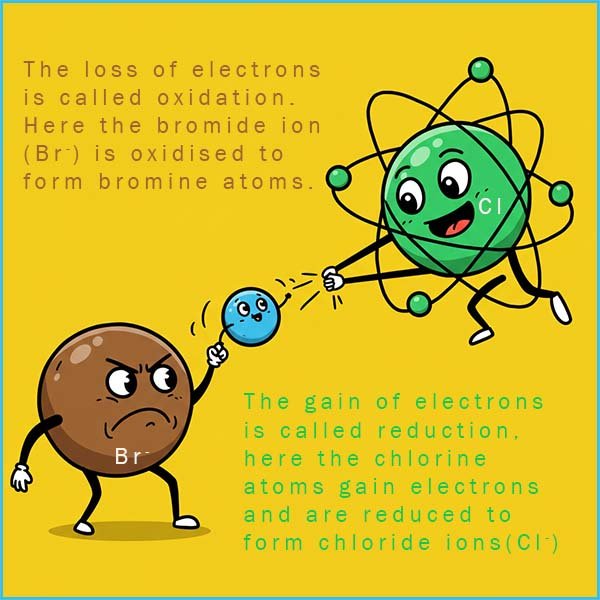
Higher and foundation tiers
 One of the many fun reactions you can carry out with halogens are displacement reactions.
Displace means to kick-out or get rid of! Displacement reactions
are a good way to demonstrate
the order of reactivity of the halogens. Remember the most reactive
halogen is fluorine and the
reactivity of the halogens decreases as you descend group 7 of the periodic table.
One of the many fun reactions you can carry out with halogens are displacement reactions.
Displace means to kick-out or get rid of! Displacement reactions
are a good way to demonstrate
the order of reactivity of the halogens. Remember the most reactive
halogen is fluorine and the
reactivity of the halogens decreases as you descend group 7 of the periodic table.
In a halogen displacement reaction all that happens is a more reactive halogen will kick out or displace a less reactive halogen from its solution or salt, for example if you have a solution of say potassium bromide; which contains the halide ion bromide (Br-) then if you add a more reactive halogen such as chlorine it will knock out or displace the bromide ion from the solution and take its place to form a solution of potassium chloride and bromine.
Displacement reactions can be carried out using aqueous solutions of the halogens; that is solutions of the halogens dissolved in water. Examples of these displacement reactions are explained in the video below. Here examples of halogen displacement reactions using chlorine water, bromine water and iodine solutions are shown along with the colour changes which are used to indicate that a halogen displacement reaction has taken place. This page explains how to use an organic solvent such as cyclohexane or hexane in a halogen displacement reaction and the colour changes to look out for which indicate that a reaction has taken place.

The halogens Chlorine, Bromine and iodine are all toxic gases, liquids and solids so they are often dissolved in water to make it easier and safer to handle them; for example chlorine dissolves in water to form a very pale green solution called chlorine water, similarly bromine dissolves to form a brown solution called bromine water. Iodine however is barely soluble in water; so to prepare iodine solution solid iodine is dissolved in a solution of potassium iodide and gently heated until the solid iodine dissolves to form a dark brown solution, which is simply referred to as iodine solution. Fluorine is simply too reactive to dissolve in water.
Fluorine will react with water to form a weak acid called hydrofluoric acid and a mixture of oxygen and ozone gases. It is highly unlikely that you will ever handle fluorine gas, fluorine is exceptionally dangerous and will react with almost everything; often violently. Fluorine gas is highly toxic, inhalation can cause severe respiratory damage which can be fatal and contact with the skin will cause deep and penetrating burns.
 Recall also that a solvent is a liquid that is good at dissolving substances, e.g. acetone is an
excellent solvent
used in nail varnish remover. Ethanol is another good solvent used in many perfumes and perhaps the
most common
solvent we use in science is water.
Recall also that a solvent is a liquid that is good at dissolving substances, e.g. acetone is an
excellent solvent
used in nail varnish remover. Ethanol is another good solvent used in many perfumes and perhaps the
most common
solvent we use in science is water.
Some substances are soluble in water but many are not; for example if you add oil to
water it simply
floats on top of the water. Oil and water do not
mix, they are immiscible.
Many of the common solvents we use in
chemistry do not mix with water, but like oil they simply float on top of the
water.
The set-up for a typical displacement reaction experiment is shown in the image below. In the first test-tube we have a solution of sodium iodide dissolved in water. On top of this is added a few centimetres of the solvent cyclohexane. Cyclohexane is a very good solvent for halogens and given the choice between dissolving in water and dissolving in cyclohexane, a halogen such as chlorine, bromine or iodine will always dissolve in cyclohexane before water. Cyclohexane is immiscible with water; that is like oil it floats on top of the water. You can see this in the first test tube in the image below.

Now Sodium iodide dissolves
in water to form a colourless solution containing sodium ions (Na+) and chloride ions (CI - ).
When chlorine water is added to the test-tube containing the sodium iodide solution and cyclohexane and then shaken for around 30 seconds you can see in the image above that the
cyclohexane layer has changed colour, it has turned a violet/purple colour.
It may be easier to understand what is happening here if we write an equation for the displacement reaction that has taken place:
On the reactants side of the word equation we have two halogens present, iodine
in the form of iodide ions in the sodium iodide solution and chlorine from the chlorine water.
In a displacement reaction the more reactive
halogen will kick-out or displace the less reactive halogen from its compounds, in this case chlorine
will displace iodide from the sodium iodide solution. The chlorine effectively takes the place of the
iodide ions. The iodide ions are now kicked out of the solution and now have a choice of places to go to; either into the
cyclohexane layer or the aqueous (water layer). Iodine is more soluble in the
cyclohexane layer rather than the aqueous (water) layer and so most of the iodine will dissolve in the cyclohexane turning it a vivid purple colour. Some iodine will also be dissolved in the aqueous layer turning it a light brown colour.
The halogens chlorine, bromine and iodine are not particularly soluble in water and tend to form solutions with rather washed out colours, while an advantage of cyclohexane is that the halogens form vivid coloured solutions when dissolved in it. Iodine forms a purple coloured solution, chlorine forms a green/yellow solution and bromine solution is red-brown. So the purple colour of the cyclohexane above as mentioned is due to the iodine dissolved in it.
In the example shown in the image below we again have 2 halogens on the reactants side of the equation; these are bromine; in the form of bromide ions from the sodium bromide solution and chlorine from chlorine water. Since chlorine is more reactive than bromine it will displace the bromide ion from the sodium bromide solution, the bromide will be kicked out of solution and most of it will dissolve in the cyclohexane layer, turning it red/brown. However some bromine will also dissolve in the aqueous sodium chloride layer turning it a pale yellow colour.

Equations for this displacement reaction are:

Care is needed sometimes when considering halogen displacement reactions as you can get caught out quite easily! Consider the reaction shown on the right. Here we have a solution of sodium chloride in the boiling tube with iodine solution being added to it. Equations for this reaction are:
You may recall that oxidation can be defined as a loss of electrons and reduction as a gain of electrons. Consider again the halogen displacement reaction which occurs when chlorine water is added to a sodium bromide solution. Now sodium bromide is an ionic compound containing sodium ions (Na+) and bromide ions (Br-).

The product of this displacement reaction is sodium chloride and bromine. This means that as the reaction takes place the bromide ions (Br -) are being oxidised, that is they are losing electrons to form bromine atoms and the chlorine atoms are gaining electrons or being reduced to form chloride ions (Cl-). We can show this as:
Both of these equations needs to be multiplied by two since the halogens exits as diatomic molecules. So as well as being a halogen displacement reaction the reaction of sodium bromide and chlorine is also a redox reaction, where the more reactive halogen oxidises the less reactive halide ion. The more reactive halogen is acting an oxidising agent (electron acceptor) the less reactive halogen is acting as a reducing agent (electron donor).